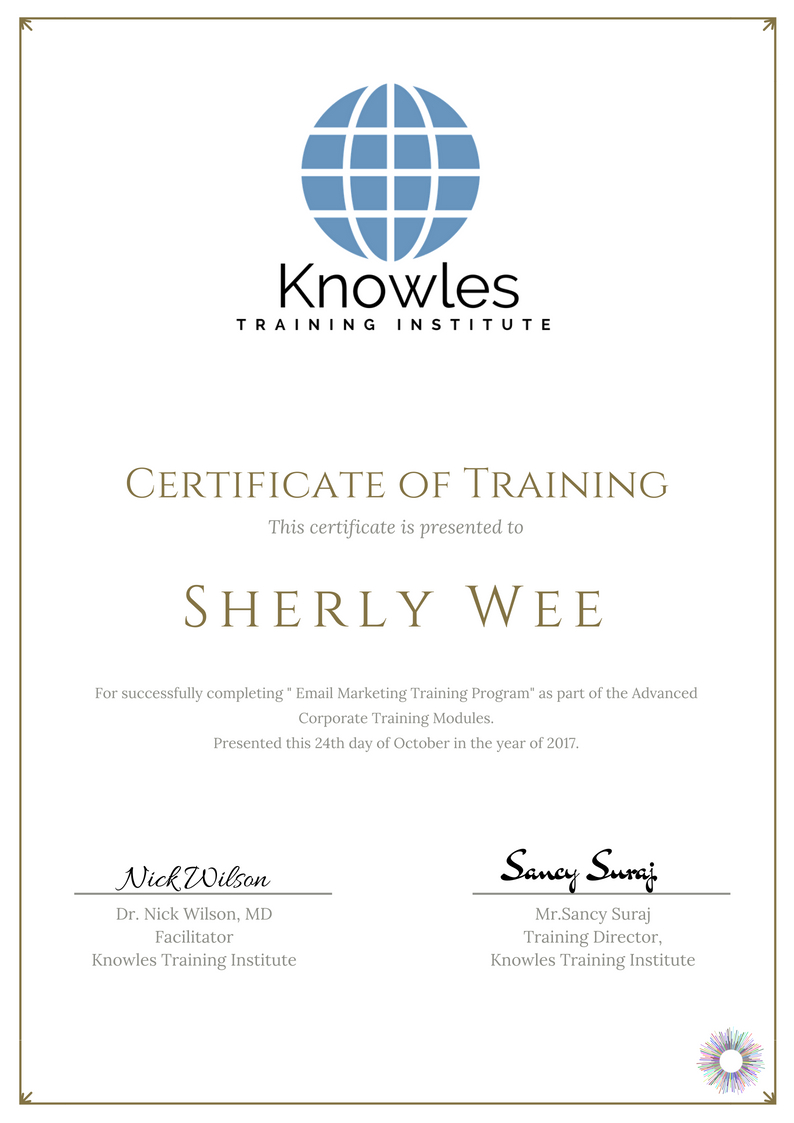Email Etiquette Training Course in Singapore
About This Email Etiquette Training Course
Email Etiquette Course in Singapore
Some might think that with the fast-paced technology, email would soon be obsolete. On the contrary, email marketing remains one of the most effective tools to send a message to potential buyers in the market today.
Who Should Attend This Email Etiquette Training
This Email Etiquette training is ideal for anyone who would like to gain a strong grasp and improve their Email Etiquette.
All Staff Within An Organisation
Managers
Team Leaders
Executives
Assistants
Officers
Secretaries
Group Size For This Email Etiquette Training Program
The ideal group size for this Email Etiquette course is:
Minimum: 5 Participants
Maximum: 15 Participants
Course Duration For This Email Etiquette Skills Course
The duration of this Email Etiquette training is 1 full day. Knowles Training Institute will also be able to contextualised this workshop according to different durations; 2 full days, half day, 90 minutes and 60 minutes.
1 Full Day
9 a.m to 5 p.m
Course Content For This Email Etiquette Training Course
Below is the list of course content of our Email Etiquette training course
- What is email etiquette
- The Do’s & Don’ts of email etiquette
- Having a clear subject email line
- Professional signatures
- All about salutation
- Proofreading your emails quickly
- Replying to angry emails
- Responding in a timely fashion
Email Etiquette Certification
Each course participant will receive a certification of training completion

Course Fees
There are 3 pricing options available for this Email Etiquette training course. Course participants not in Singapore may choose to sign up for our online Email Marketing training course.
1-Full Day Course
- Learner’s Guide
- Course Handouts

Fill up the form and we will get back to you in less than 1 working day.
Alternatively, give us a call to have one of our training consultants contact you. Our corporate training courses can be contextualized to meet your organization’s training needs. Leverage on our large pool of professional trainers and consultants for your organization’s training needs.
Office Address: 60 Paya Lebar Rd, #07-54 Paya Lebar Square, Singapore 409051
Office Phone: +65 6714 6663
Email: contact@knowlesti.sg
We Guarantee 100% Privacy. We Respect Your Privacy. Your Information Will Never Be Shared.
Questions
Email etiquette is concerning respect and common sense. The same type of professionalism you require other people to give you is also critical when composing your communications.
Verbal and written conversations are guided by etiquette. The basis of proper etiquette is behaviour that is perceived as polite in social, professional situations. Good manners can mean be the difference between success and failure. Showing adequate etiquette is essential to any civilization.
Using bad judgment in an email to your management, boss, colleague, or client, you have created a record of your error that could come back to hurt you. While typos are common and a thing of its own, there are some glaring mistakes people make when writing a professional email.
These five things should never show up in a professional email.
- Emojis
- ‘LOL’
- Informal salutations
- Gossip
- Jokes
Emails have replaced business letters, and it requires lesser effort to respond to an email.
You can make it easier for your recipients by making sure your business emails include these five essential elements.
Five Rules Email Etiquette:
- A Concise, Direct Subject Line.
- A Proper Greeting.
- Proper Grammar, Correct Spelling.
- Only Essential Information.
- A Clear Closing.
As we work faster and more efficiently, we must not forget the social practices that follows any types of communication.
The Dos of Email Etiquette
- Clear Subject Line
- A signature
- Proofreading your messages
- Response to all emails
- Keep private materials confidential
The Don’ts of Email Etiquette
- Using informal salutation
- Using humour
- Assuming the recipient knows what you are talking about
- Sending a written email out of emotions
- Overusing exclamation points
How to write an email:
- Write a catchy email subject line – The main takeaway of a thread
- Keep it short – do not write a novel
- Get to the point
- Make it personal
- Include a call to action – What is there to be done from the recipient end once the email has been read?
- Always follow up
- Hit send at the right time – Is your email with a call to action sent on an inappropriate hour?
Rules of Etiquette
- Be yourself
- Say “Thank You”
- Give Genuine Compliments.
- Don’t be Boastful, Arrogant or Loud.
- Listen Before Speaking.
- Speak with Kindness and Caution.
- Do Not Criticize or Complain.
- Be Punctual.
Email is the most popular method of business communication, so it’s essential to get it right. Emails are typically aren’t as formal as letters. However, they are required to be still professional enough to present the right image of you and your organization.
Here is how you can professionally respond to an email:
- Begin with a greeting.
- Thank the recipient for sending out the email
- State your purpose of response
- Add your closing remarks
- End with an appropriate closing with your name
Boomerang’s analysis found that the average reply time is about 23 hours, but that is because there is a good chunk of people who are responding to emails late.
50% of responses takes 2 hours, and research from one study has shown that the most typical email response time is 2 minutes.
Fun fact, more than 70% of people expects a reply from colleagues within 4 hours.
“FYI” can come off as harsh and can quickly become a tool in passive-aggressive communication when including it in an email to or from someone else
“FYI, you should have known about this” –
You can instead, rephrase it as ‘By the way, in the case that this was missed out, I just want to mention again that….’
Make your message clear with grace and politeness so that the email does not rub the recipient in the wrong way or make them think that there is a hidden motive behind it.
There is a need to acknowledge numerous kinds of emails in business. Professionals find it essential to add further information to an acknowledgment email that they send out. As such, acknowledgment emails are now a critical role in business.
Here’s what you should remember when writing acknowledgment emails:
- Strengthen agreements or revise the terms of the contract if you are at the point of reaching an agreement.
- Notify clients that you have read their emails, so they know how to proceed.
- Inform your client should there be any changes in any agreement
If you are requesting something to be done or acknowledged in a professional email, it is imperative that you explain what you require and make sure to ask it in the right manner. If you don’t, there is a good chance the person will say no as they will be annoyed with you for not being direct or polite.
A formal email containing a request is simple and straightforward:
- Begin the email by explaining what you are writing about and what the purpose is
- Ask them the questions or lay your request clearly
- End your email by stating when you need the information by
- Thank them in advance for doing what you require them to do
Sometimes we do not respond to emails right away. Sometimes we delay it until the next day, week, or month.
While it is not appropriate, sometimes, you have to own up to the late response.
You can try:
- My apologies for the slow reply
- Sorry for the delayed response
- My sincere apologies for the slow reply
No matter how they happen, errors are a fact of business. One way or the other, you will have to transmit out an apology email. Email keeps things in writing, and everyone gets a date-stamped, time-stamped report of the conversation.
Here are some ways you can apologize via email:
- I am sorry. I did not realize the impact of
- Please accept our deepest apologies for
- Please accept my sincere apologies for
- Please accept this as my formal apology for
- Please allow me to apologize for
- I would like to express my deep regrets for
- I would like to apologize on behalf of our company
How you end, your email is important. It is your ultimate chance to make an excellent first impression on the recipient.
What is the best way to end a letter or email message? Your closing needs to give the recipient positive feelings about you.
Closing Examples:
- Sincerely Regards, Yours truly, and Yours sincerely
- Warm regards, Best wishes, and With appreciation
- Many thanks, respectfully, warm wishes, yours cordially
PS stands for postscript. It originates from the Latin post-scriptum, which means “written after.” A postscript is an added thought added to written messages that come after it is completed.
If the thought of sending out a follow-up email makes you feel uncomfortable, you’re definitely not alone. Your senses tell us that if someone has not responded to your original email, they are not interested.
When you do send it out, it is critical that you keep the following in mind.
- Before drafting the email, put yourself in their shoes and ask yourself how often you would want to receive a follow-up email and how you would like for it to be drafted.
- Add context
- Add value
- Explain why you’re emailing
- Include a Call-To Action
Post-Training Support: A vast majority of training does not have any effect beyond 120 days. But to work, training has to have a strong pre- and post-training component. Post-training reinforcement consequently helps individuals to recall the understanding and ask questions.
Blended Learning: Learning does not occur in the classroom. Virtually everybody prefers distinct ways of learning. Successful learning should have a multi-channel, multi-modal strategy.
We Understand The Industry: Similarly, we’ve got a profound comprehension of the business, business design, challenges, strategy and the that our participants are in and have designed the courseware to cater to their professional needs.
Course Content: Knowles Training Institute’s material is relevant, of high quality and provide specific learning outputs. As a result, Participants will leave the training course feeling as they have gained a strong understanding and will also be in a position to execute what they have learned sensibly.
Course Development — The workshop modules follow a systematic and logical arrangement. Therefore, this structure helps to ensure that the course material allows the facilitators to deliver the course in a logical arrangement. Consider the subjects as building bricks into learning, our facilitators slowly build towards a comprehensive picture of this entire topic.


https://www.businessinsider.sg/email-etiquette-rules-every-professional-needs-to-know-2016-1
https://www.inc.com/guides/2010/06/email-etiquette.html
https://www.entrepreneur.com/article/272780
https://www.lifewire.com/fundamental-email-etiquette-1171187
https://www.huffpost.com/entry/5-rules-of-email-etiquett_b_4860133


